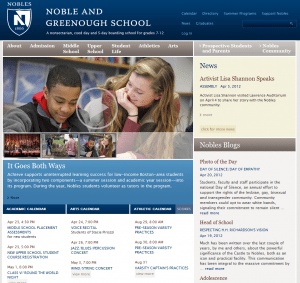Seven Blogging Lessons for Marketing Your Private School
As you think about the power of blogging for your school, I wanted to share with you some advice based on what I have experienced and seen in the marketing strategies of private schools.
First, to be effective in blogging, a new article should be written and published at least once a week on the same day that contains 300-600 words and a photo. Readers appreciate the consistency in your blog postings and this will keep them engaged in what you have to say. If you can’t keep up with this once-a-week writing strategy, you might want to put off implementing a blog until you can. In addition, as you write your articles, make sure to use short paragraphs and subheadings to break up the copy.
 Second, be careful not to bury your blog on your website. The ideal placement for your blog is on the homepage of your school’s website. This provides a primary place for content that will be dynamic–especially if you post a new article every week. The following are some examples of school websites that have a blog on their homepage: Phillips Exeter Academy, Noble and Greenough School and Sewickley Academy.
Second, be careful not to bury your blog on your website. The ideal placement for your blog is on the homepage of your school’s website. This provides a primary place for content that will be dynamic–especially if you post a new article every week. The following are some examples of school websites that have a blog on their homepage: Phillips Exeter Academy, Noble and Greenough School and Sewickley Academy.
Third, while you may be tempted to start a free blog on a site like Blogger or WordPress, your blog should be attached to your domain. Here’s the rule to follow: If your blog has the name of another blog site in your URL, then that site will receive the SEO value instead of your school’s website. Your blog URL should be either blog.yourschoolURL.org or yourschoolURL.org/blog.
You can still use WordPress, and I recommend that you use this site, but make sure you use WordPress.org (not the .com version) and have someone from IT help you set it up on your domain. Check out the Sewickley Academy website to see how this works.
Fourth, use a team to strategize and write your school’s blog posts. While it is possible to have one person write all of your posts, it usually works best if you take the team approach. This group can strategize and write the content. And if your team has four members, that means that each person only has to write one post per week. It’s the divide and conquer blog writing strategy.
Fifth, don’t use your blog to sell your school. There are other outlets for self-promotion. Instead, use your blog to tell human interest stories that are engaging and interesting as well as to communicate content that might be helpful to the reader. For example, a blog post about your upcoming auction will likely only get read by a few. However, a post on the life-changing service trip or five strategies for success in your college search will be read by many. And, this will not only reach your internal audience it will provide content to reach your external community.
Sixth, make sure you set up your blog with a RSS feed option, subscription list and share/like buttons. For example, my blog includes all three of these options. I especially like the built-in subscription list. My site collects the emails subscriptions as people opt-in to receive my new blog posts. This is integrated and maintained in MailChimp. Every time I write a new blog post, it is automatically sent to my email subscription list at the time I want it to be delivered. This could be a great tool for visitors to your website, including prospective parents, alumni, donors and friends, to opt into receiving your blog post in their email. And what’s really cool about this feature is that you can see who opens the blog post and clicks on the links. You will probably need someone in IT or a Web company to help you with this, but I highly recommend it.
Seventh, use keywords within your blog posts to help drive search traffic to your articles. You will want to focus on one or two longtail keywords that you can use in the copy that a parent might use in a search. This will help build relevant content on the Web that includes important keywords that will help drive traffic to your school’s website.
Are there any other blogging lessons that you can offer based on your experience?
What have you learned about blogging in your school’s marketing strategy?
